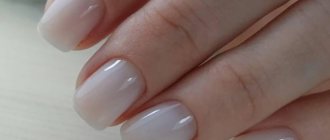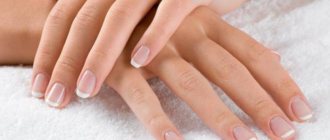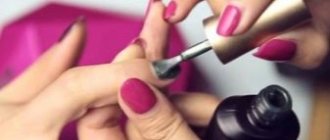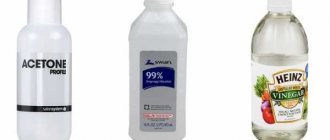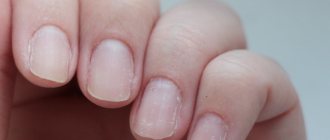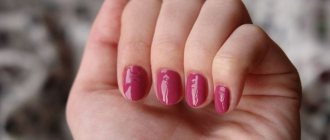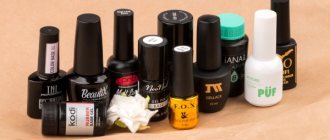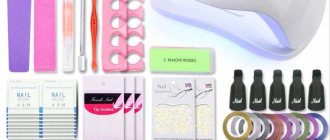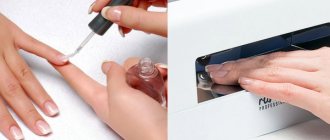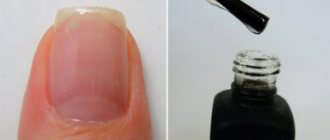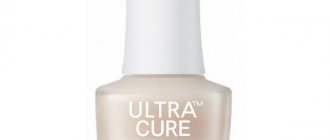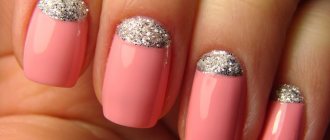What is camouflage nail base?
The composition serves as a base layer for applying the finishing coat. Camouflage comes in different consistencies and shade palettes. Pastel colors are often used because they best match the natural color of human skin. Thanks to this, the modeled nail plate looks as naturalistic as possible.
Natural tones:
- universal;
- always relevant;
- fit perfectly into any dress code;
- fit well with various outfits.
This is the best option for girls with thin and flaky nails. With its structure and density, the camouflage cosmetic composition resembles a natural nail plate. This manicure looks as naturalistic as possible.
The camouflage is polymerized under the influence of an ultraviolet lamp or LED radiation. The nail extension procedure does not take much time and does not require special skills.
The naturalness of a nude manicure based on a camouflage base allows you to successfully combine it with fashionable wardrobe items and accessories, and the variety of body colors allows you to choose a shade to match the color of the skin of your hands and face.
The composition forms a thin and durable polymer film with increased adhesive properties on the nail plate. It is great for doing your own extensions and creating a flawless manicure at home.
The viscous material makes the nail plate absolutely smooth. It provides air access to tissues, preventing the development of fungal microflora and the occurrence of an inflammatory process in the most sensitive area of women's hands.
How to choose a base for gel polish?
The selection criteria depend on how strong or fragile the nails are, soft or hard, healthy or flaking. Increased hand humidity or sensitive skin also influence the choice of brand and characteristics.
Consistency
Liquid products are applied faster and heat up less in the lamp, as they do not allow a thick layer to be applied. Thick compositions require longer application, but they are easier to model the correct architecture.
Type
Self-leveling bases are ideal for beginners or when nails do not require restoration. Very thick reinforcing bases for additional extensions require certain working skills. It takes some getting used to using such products. Some bases have a natural shade that covers color defects in the nail.
Compound
Organic monomers provide ideal coating durability. Rubber substitutes provide a thick, rubbery consistency and allow the coating to self-level.
Manufacturer
Technologists convince us that products interact best with each other if you use only one brand of manicure products. Masters often break this rule by choosing gel polishes from different manufacturers, but for reliable results they use the base and top coat of the same company.
The quality of work and the final result directly depend on the application technique. The nail plate must be thoroughly degreased and prepared. The product is applied in two stages:
1. Apply a thin layer using rubbing movements.
2. Alignment.
What is camouflage used for?
Nude manicure based on rubber, acrylic or silicone is used to lengthen and strengthen the nail plate, disguise aesthetic flaws and anatomical defects. In a three-stage system, camouflage serves as the foundation on which the gel polish rests. Therefore, increased demands are placed on its strength and reliability.
The camouflage base (what kind of polymer it is is a separate question of choosing a product) can be acrylic, silicone or rubber. It can be made nude, pastel or transparent. The last option is used when creating an artistic French manicure - a French manicure.
The main purposes of camouflage:
- nail plate modeling;
- improvement of its anatomical structure;
- correction and masking of various defects;
- creating a durable base for applying gel polish;
- increasing the durability of manicure;
- protection of fabrics from the harmful effects of chemically aggressive coloring pigments;
An important function of the polymer foundation is to level the surface to distribute the finishing layer.
Camouflage gives destructive nail plates with microcracks, tubercles, and other aesthetic defects a uniform texture. On such a surface, the manicure retains its original appearance longer than usual. In addition, the base thickens the nail plate and makes it stronger.
Often nude camouflage is used for gel polish coating with:
- shimmer;
- sparkles;
- silver plating;
- original mirror or futuristic titanium effect.
The polymer base performs a healing function, resuscitating and restoring the natural structure of the nail plate after removing a chemically aggressive colored manicure. Its formula has a beneficial effect on the surrounding skin.
Features of camouflage gel polish
The appearance of the material resembles a viscous substance that polymerizes in a UV lamp. The texture of the extension gel is similar to the structure of the nail in density, so after modeling it is difficult to distinguish them from real ones.
Initially, the products were created to simulate a French jacket and strengthen a natural plate, after which the craftsmen also came up with several points why camouflage gel was needed.
Among the advantages, a camouflage coating can correct imperfections and create a plate made of artificial material similar to a natural one. The main advantage is that the composition allows tissues to breathe under layers of polymer without causing fungal formations or inflammatory processes. When applied correctly, the artificial nail grows with the natural one, without chips or cracks.
Quite often, a camouflage polymer acts as a treatment for weakened nails. When the natural cover is damaged or injured by accident, the composition fills the deformed area and creates the most even surface, and sometimes even adjusted taking into account the structural features of the finger.
Application Features
To create a flawless manicure based on camouflage, a special coating technology is used. Gel polish applied in this way lasts a long time, without chipping, peeling, or scratching. In salons, masters pre-prepare the nail plate for the procedure.
The camouflage base (what it is and the sequence of actions for application are described in the instructions that come with the manicure composition) is applied only to a cleaned and degreased surface. Professional training is carried out using a special apparatus.
With its help, they eliminate impurities, remove the cuticle, and remove dead fragments of the epidermis surrounding the nail plate. At home, you can use the accessories of a manicure set - tongs, a regular nail file, and a sanding buffer.
A primer is applied to the treated surface. When decorating the nail plate with a camouflage polymer, you can use a composition of a dark shade to create. expressive boundary between the bed and the edge contours.
In the fashion trends of French manicure, a polymer base of a three-layer design is used in conjunction with gel polish of a delicate milky shade. In case of severe destruction of the nail plate, it is advisable to use camouflage of the most dense consistency with a high viscosity index.
Types of Camouflage Gel
There are 3 phases of the masking polymer base. Each type has its own purpose and is used for different types of nail plates. You need to select the base individually, depending on the desired effect.
The phases are different:
- consistency;
- chemical properties;
- physical and mechanical characteristics;
- provided by the application technology.
All of them perform a leveling function and ensure reliable adhesion of the gel polish to the surface of the nail plate.
1-phase
This is the most commonly used and easiest to apply polymer manicure base.
This composition is usually transparent in color, of medium thickness and viscosity, and does not bubble.
It polymerizes quickly when exposed to ultraviolet radiation.
Once completely dry, it can be easily given the desired shape by filing or polishing.
A 1-phase type camouflage base ensures reliable adhesion of the nail plate to subsequent layers.
What does it give:
- manicure lasts a long time;
- is highly resistant to external factors;
- has an impeccably aesthetic appearance;
- Easy to apply gel polish with shimmer, glitter, silver effect.
This acrylic or silicone base can be used to create a uniform matte or glossy finish and form any image.
2-phase
This type of camouflage base has a thinner consistency, making it a little easier to work with. It is used for nail extensions while simultaneously strengthening them. 2-phase camouflage is applied to an architectural base coat to give the manicure the most natural look. This base is applied in 3 layers.
Each of them has its own functional purpose:
- 1st – ensures reliable adhesion of the gel polish to the nail surface;
- 2nd – corrects anatomical errors of the plate;
- 3rd – consolidates the leveling effect.
This polymer is not very popular because it does not give as durable a result as the previous option.
3-phase
These camouflage bases are the most liquid. The composition quickly spreads over the surface of the nail. The 3-phase base is applied in an extremely thin layer. To thicken the nail plate, successive repeated applications are required after the lower tier has dried.
Due to its liquid consistency, this composition is prone to the formation of bubbles. To avoid this undesirable effect, the polymer is distributed over the surface of the nail slowly, carefully, thoroughly.
Creating a manicure based on a 3-phase camouflage base takes a lot of time. But the result is excellent. This coating is not afraid of mechanical stress.
Types and phases of camouflage manicure
Depending on your goal, you can reduce or increase the number of layers. For each method there is a specific varnish. Some time ago they began to be divided into single-phase, two-phase and three-phase.
The first phase involves preparing the nail surface, the second – modeling, the third – fixing.
Single phase gel
Some varnishes perform 2 or 3 functions simultaneously and reduce the number of phases.
Single-phase camouflages
Single-phase gel varnishes are also called 3 in 1; they are applied in one layer and serve as a primer, varnish and top coat. They are used primarily to strengthen your own nails. These varnishes have a liquid texture and do not allow you to model the shape of the nail. However, they do a good job of adhesion, leveling and adding gloss.
Applying gel polish
Most single-phase gel polishes receive rave reviews from customers.
Two-phase and three-phase camouflages
These varnishes combine the functions of a prime or top coat with a modeling function. They are usually somewhat more expensive than conventional gel polishes, but they allow you to replace 2 components in the coating without compromising quality. This material should be applied in as thin layers as possible.
Three-phase gel pink
Three-phase camouflage gel polish is applied following all three stages. Used as a camouflage base for gel polish, when performing the most complex manicure, it allows you to model the shape of the nail. When applying, do not forget to dry each layer in an ultraviolet lamp.
Advantages and disadvantages
The camouflage base gives the nail plate anatomical perfection, high strength, and absolute smoothness. The list of advantages of the polymer base is not limited to this.
Some of the important advantages of such a multi-layer manicure include:
- strengthening weakened and damaged nails;
- the content of special biologically active components that prevent fungal infection and the development of the inflammatory process;
- a unique polymer coating formula that ensures free penetration of the atmospheric mixture into fabrics;
- long service life of the cosmetic coating;
- natural look;
The camouflage base (what it is and what its features are described in the article) does not allow the multilayer coating to delaminate. It is ideal for fans of fashionable French manicure - French. Polymer material is not without a number of disadvantages.
The most significant of them:
- the high price of a camouflage base, extension procedures and aesthetic correction of nail plates;
- the need to re-manicure monthly;
- some components of such compositions can cause allergic reactions;
- If the application technology is not followed, you can damage your nails;
Improper use of a UV lamp results in microscopic burns to the skin. One of the disadvantages of this manicure is the duration of the nail extension process.
Camouflage base color
The modern beauty industry is trying to reach the widest possible range of consumer audiences. Therefore, manufacturers produce camouflage compositions for any color type of appearance and skin tone.
The following colors are ideal for dark-skinned girls:
- beige;
- apricot;
- peach;
- nude;
- pale pink.
They create the most expressive color contrast. For those with fair skin, it makes sense to give preference to a translucent composition, ivory or tea rose.
By varying the thickness and saturation of the polymer coating available, you can create unique colors of the camouflage base for gel polish with shimmer, shiny inclusions, and a silver effect.
The manicure base in the rare shade of Ivory Idy, a delicate creamy color, looks very expressive on sultry brunettes.
The most unusual colors of commercially produced nude camouflages:
- "languid kiss";
- "almond roast";
- “cream praline”;
- "bold peach"
All of them belong to the palette of flesh tones and represent a darkened or lightened variation of the classic beige color of different viscosity and color saturation.
Warm colors (peach, apricot and others) emphasize the graceful glow of a bronze tan or dark skin. Such camouflage bases are relevant for the summer period. A modern classic of the genre is considered a transparent polymer in combination with a French manicure.
A splash of snow-white pigment will add a touch of frosty mood to any girl’s summer look. For silver gel polish, it is advisable to choose a nude base that is close to a yellow-beige color. For a manicure with glitter, a nude camouflage base is perfect, as close as possible to the natural skin tone.
How to make the right choice?
You need to focus not only on the color of the base, but also on other criteria. One of the most important is the type of polymer composition. Rubber-based products are intended for aesthetic correction and modeling of the natural anatomical structure of the nail plate.
This wood resin lays down in an even layer, increases the thickness of the surface, and gives the composition thickness and ductility. Rubber bases are great for smoothing out problem nails. They are recommended for owners of thin and fragile plates. This polymer prevents the formation of microcracks.
A camouflage base (what it is and why it is needed is described in the article) is selected depending on the desired effect and the condition of the nail plates. Manicure compositions based on acrylic powder are popular.
It polymerizes under the influence of ultraviolet radiation and forms a thin but very durable film. Then another layer is applied, thoroughly polished, and only then gel polish with shimmer, glitter, silver or another effect is applied.
The tandem of an acrylic camouflage base with a finishing coat forms a durable nail frame. It prevents the plate from delaminating and ensures the durability of the manicure. Its only significant drawback is the difficulty of removal.
A silicone base is also often used. It is produced both in a gel-like state and in the form of stickers. The first option is chosen for flawless leveling of the damaged nail plate. Gel-like silicone has good sealing properties and a viscous consistency.
Stickers are suitable for those who want to restore the natural shape of their nails or lengthen them. This base does not require polymerization and can be easily removed. The most breathable coating is created by a water-based liquid camouflage base. Its main disadvantage is the fragility of the manicure.
Popular brands of camouflage gel polishes
There are a huge number of famous and not so famous brands on sale that produce and sell components for plate modeling. When purchasing camouflage gel, you need to make sure, firstly, that the brand produces high-quality products, and secondly, whether there is an expiration date and production date on the jar.
Choosing a manufacturer is quite difficult, since all brands have a good reputation and excellent reviews. However, some nail artists use a certain camouflage product, which, in their opinion, is the most practical and is worn without peeling or cracking. In many ways, this fact depends on the working methods of the specialist himself and on the step-by-step application of all layers.
The composition of all brands is almost the same, with the exception of small nuances. Some brands have a rich pigment in the gel, while others prefer to create a translucent camouflage extension product. The presented brands produce single-phase, two-phase, and three-phase gels for strengthening and extending nails.
bluesky
The first position in our mini top is occupied by the Bluesky brand. The brand is very popular both among ordinary girls and among nail experts. Camouflage has a dense and thick consistency, ideal for correcting the plate and eliminating various defects.
The product is sold in a white jar with a convenient lid and bottom for working. Builder polymer is sold in a volume of 15 ml, the average price is no higher than 400 rubles per unit.
Haruyama
Among the famous manufacturers, the Japanese brand Haruyama, which produces camouflage gel in 10 ml, is distinguished by its special quality. The price per unit varies from 250 to 300 rubles, but there are jars of different sizes. You can choose a convenient format for professional work in the salon.
The composition contains rubber, which makes the base viscous with a thick texture. It is ideal for beginners because it does not spread when laying out and drying.
Rubber camouflage
Rubber camouflage is a product line from the popular TNL brand. The brand produces a huge number of high-quality tools for manicure and pedicure, including hybrid and ultraviolet TNL lamps, varnishes, tops, bases, camouflage material, rhinestones for decoration, and bouillons.
As for the composition, it creates a perfectly smooth surface with stunning shine. The tube of modeling material contains rubber, which gives a viscous consistency and dense texture.
Cody
You can choose camouflage gel from the manufacturer Kodi. The volume of the product varies, ranging from 14 ml to a 45 ml jar. However, the brand has only two colors for modeling the bed: rose and peach. It is better to purchase a three-phase polymer and use French varnishes. The palette of varnishes has beautiful shades suitable for painting the plate in a natural tone.
How to use camouflage nail base?
This procedure is carried out mainly in beauty salons. If you follow the technology of applying a camouflage base and gel polish, you can create a flawless manicure at home.
The figure shows the rules for using a camouflage base to straighten nails.
Step-by-step instruction:
- First, prepare the nail plates by cleaning and degreasing them.
- Perform a standard hygienic manicure, removing dust with a soft buff.
- The nails are given the desired shape by filing.
- Then the extension form is applied so that its center coincides with the middle of the native nail plate.
- The template is securely fastened.
- Next, use a brush to grab a small amount of camouflage polymer and distribute it in a thin layer evenly over the entire surface to be treated.
- Polymerize under a UV lamp for 2 minutes.
- Remove the dispersion coating and use a manicure file to give the nail plate streamlined contours.
If the camouflage base is applied in several layers, each of them polymerizes for 2 minutes. after the previous one has completely dried. Upon completion of the process, the template is removed and a fixing gel polish is applied.
Technique for nail extension using camouflage
The extension procedure is carried out mainly in salons, but if you wish and follow all the rules for working with materials and equipment, you can perform extensions at home.
The entire procedure for working with camouflage gel is carried out in several stages:
- We prepare and treat hands and nails, that is, we carry out a standard hygienic manicure.
- Degrease the nail plates.
- Apply primer and cure it in a lamp.
- Next, prepare the artificial form and place it on the nail plate so that the center of the nail coincides with the center of the form.
- We put a certain amount of gel on the brush and distribute it evenly over the surface of the mold, starting from the middle and moving towards the free edge. At this stage, we model the required length and desired shape of the extended free edge.
- The formed fragment is polymerized in a lamp.
- Then we cover the natural plate with base gel and dry it. This is done for better adhesion.
- Apply the base coat again to the fragment and the entire nail, but do not dry it.
- Using a brush, pick up a certain amount of camouflage and place it in the middle of the nail plate. Using even smooth movements of the brush, we distribute it over the entire plate, trying to get no closer than 1 mm to the cuticle and ridges.
- After the material has been laid out on the surface, we place it under the lamp for 15-20 seconds. Then we press the gel with a special clothespin, and again send it to polymerize until completely dry.
- We remove the mold, the sticky layer, file the free edge, and sand the surface with a buff.
- If subsequent design and decoration is not provided, then apply a finishing coat, seal the end and dry in a lamp until the top is completely dry.
You can more clearly familiarize yourself with the technique of modeling and extending nails with camouflage material by watching the video:
Initially, camouflage gels were invented and developed to create the perfect jacket. An example of such a manicure is shown in detail in the video:
With the help of camouflage material, you can carry out not only the process of building up nail plates, but also carry out the procedure for strengthening them. You can learn more about the technique by watching the video:
Review of camouflage nail bases
Polymer compositions from all manufacturers have virtually identical chemical formulas, with the exception of the coloring pigment used. When choosing, you need to make sure that there is no allergic reaction to it.
List of popular camouflage bases for gel polish with shimmer, sparkles, silver:
| Name | Product Description | Volume | Price |
| CND Base Coat | The composition has a dense consistency. Polymerizes in 30 seconds. Compatible with any gel polish coatings. Ideally aligns the nail plate. Often used for gel polishes with shimmer. | 12.5 ml | 1830 rub. |
| Uno, Color Rubber Base | Rubber-based composition. Thanks to its dense texture and increased viscosity, it has good leveling properties. Color – beige with a delicate pink undertone. | 8 ml | 490 rub. |
| Cosmolac Cover Base 01 | Medium consistency camouflage base. Used for leveling, toning, strengthening the nail plate. Polymerization time – 3 min. | 7.5 ml | 240 rub. |
| Kodi Rubber Base | Rubber polymer of viscous consistency. Color – nude. Suitable for any varnish gels. | 7 ml | 450 rub. |
| Klio Professional | Composition of a neutral beige shade on a rubber base. Used to smooth out lumpy nail plates. Has a strengthening effect. Polymerizes under ultraviolet light - 2 minutes, under an LED lamp - 1 minute. | 12 ml | 470 rub. |
| Haruyama Base | Medium thickness camouflage base with a neutral flesh tone. It is well distributed in an even layer over the nail plate. It is popular due to its low price. It is incompatible with colored Chinese gel polishes. | 30 ml | 600 rub. |
| Beautix Royal | Rubber polymer with self-leveling properties. Provides reliable protection against mechanical damage to fragile nails. The universal nude shade allows you to combine it with any gel polishes - shimmer, glitter, silver. | 15 ml | 990 rub. |
The products of the American brand CND are in especially high demand. Such compositions have an optimal consistency. Applying such a polymer composition at home is not difficult.
What is a color base
First, a little terminology.
Gel polish base is the first layer of a gel nail coating system. The purpose of the layer is to ensure adhesion of all other materials to the nail for long-term wear.
Initially, bases for gel polish were only transparent and differed in hardness and were divided into hard, elastic, medium and soft. A little later, camouflage bases appeared.
Unlike regular ones, camouflage ones had a light color and made it possible to cover the nails with a natural shade - pinkish, peach, milky. Camouflage was used to create a French manicure or just a calm cover, for example, for those who adhere to the dress code in the office.
2020 was a turning point for camouflages - in addition to nude, milky and pink shades, colored bases appeared. The TopShopNails brand was the first to notice unusual coatings, and later other manufacturers followed suit - now more than a dozen different companies produce color bases from translucent to dense neon.
View this post on Instagram
Post by Gel Polish (@luiphilipp_gel)
As with regular camouflages or clear bases, colored ones can be:
- Hard or hard;
- Medium hardness;
- Soft or fragile;
- Elastic.
You need to select a specific hardness based on the characteristics of the nail plate:
- For soft, bendable nail plates, a rubber base is suitable. Due to its density, it will help fix the nail, and the plastic formula will not allow the coating to crack;
- For short, dense nails, use a medium-hard colored base;
- If the natural nail plate is long, the elastic base will not work - it may sag in the stress zone precisely because of its plasticity. If the free edge is long, choose a medium-hard colored base.
Base coats come in different colors and consistencies – thick, medium or liquid. A colored nail base replaces 2 stages of coating at once - base and color. The same thing was done using regular camouflages, but colored bases added variety to the palette and now an express manicure can be done in either a green or blue shade.
View this post on Instagram
Publication from
